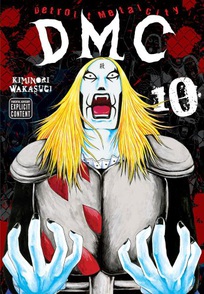Review
by Rebecca Silverman,Detroit Metal City
GN 10
| Synopsis: |  |
||
After losing to God in the metal bands death match, Soichi Negishi decides that he is done once and for all with death metal. Unbeknownst to his fellow DMC members, Soichi moves to Paris to try and become the folksy hipster musician he has always aspired to be. But when God declares himself the king of death metal, will Soichi really hang up his Krauser gear for good? |
|||
| Review: | |||
Part of the longstanding appeal of Detroit Metal City has been the dichotomy between Soichi's aspirations/personality and his career as Lord Krauser II, front man for the death metal band DMC. When readers learned that God's lead singer, the half-Swedish Hideki Karls, also has dreams of a career outside of the metal world, it just added to the fun. This remains true for the last volume in Kiminori Wakasugi's death metal pseudo-epic, and the funniest parts of the book are when the two are grappling with the reality of their talents rather than the things they want to be doing. Scenes of Hideki trying to get a modeling gig and failing miserably (although to be fair, who isn't fugly in this series?) and Soichi attempting to take France by storm are so over the top that Wakasugi bypasses pathetic and heads right into hilarious. Regretfully, these scenes do not comprise the majority of the volume. We begin with the breakup of DMC and bandmate Wada trying to get Soichi to come back. Hideki (as God) has been terrorizing other metal bands with his “God Walk” (a modified catwalk strut) to make his mommy happy. He's not hugely thrilled with his life, but at least he's chased off Krauser. No one can figure out where the lord went until chapter 104 brings us to France. In the magazine, this chapter must have been incredibly dull. It consists of scenes of Paris and the lyrics to the song “Tout, tout pour ma cherie” by Michel Polnareff. At the end of this Parisian tour we do learn why we're there, but it is hardly a highlight in a book about death metal. From that point on, Soichi wanders about Paris trying to sell his – in translation – franglais songs to the French public, even going so far as to offer people eggs to throw at him. While it is nice to see him attempting to be true to himself, and his lyrics are entertainingly stupid, these scenes do not make for compelling manga. Luckily for those intent on finishing the series, Wakasugi does not allow the book to finish on such a low note. Naturally Krauser goes back to Japan to engage in a battle of the bands with God. This is both the best and the worst part of the book. In terms of wacky metal antics, these few chapters are excellent. Krauser and God try to outdo each other with lyrics, acts of grotesquerie, and death metaphors. God “transforms” into his alternate forms while Krauser smashes the hell out of things and people. The thoughts of the two men as they try to win the impromptu battle are especially funny in a way best not revealed here. Ultimately, it is scenes like these that make Detroit Metal City great. Unfortunately these chapters also contain some of the least funny bits to grace the volume. This, it must be stressed, is purely a matter of taste. If you are of the opinion that rape and sexual abuse should never be played for laughs, some of the gags herein will offend you. If you can overlook such things, you'll get more enjoyment out of the battle. As part of the competition, Krauser plays a video of himself “raping” the Eiffel Tower. Audience members say things like “she's holding back” and “her body's relaxing.” This is somewhat eclipsed by the fact that the Eiffel Tower is one of the great phallic symbols of architecture and is in fact designated as masculine by the French language, making the joke a bit funnier. But when God flips up Yuri's skirt on stage in an attempt to prove his badass masculinity, Krauser responds by yanking off her underwear and shoving a mirror beneath her vagina. This sort of violation is not easily laughed at or forgiven, no matter if it is done in the name of comedy. Artistically, this series should give aspiring artists with little talent hope. While it may not be fair to say that Kiminori Wakasugi can't draw to save his life, he probably couldn't save a couple of his limbs. People all have a generic quality and are, as previously mentioned, seriously unattractive. Panels are fairly uniform from page to page and movement is pretty minimal. Probably the best parts of Wakasugi's artwork are the costumes. Those remain distinctive and fun to look at. Detroit Metal City should perhaps have been half the length it is, but it goes out with, if not a bang, then a promise. Soichi resolves some of his internal issues, makes an effort to get the girl of his dreams, and finds a kind of happiness. If you've stuck with the series this long, there's really no reason to stop before finishing it. It isn't the pinnacle of the comedic art, or the manga art, for that matter, but it is entertaining. If nothing else, it should make you feel the need to watch Lordi videos on YouTube. |
|
The views and opinions expressed in this article are solely those of the author(s) and do not necessarily represent the views of Anime News Network, its employees, owners, or sponsors.
|
| Grade: | |||
Overall : C-
Story : C
Art : F+
|
|||
| discuss this in the forum (2 posts) | | |||
| Production Info: | ||
|
Full encyclopedia details about Release information about |
||